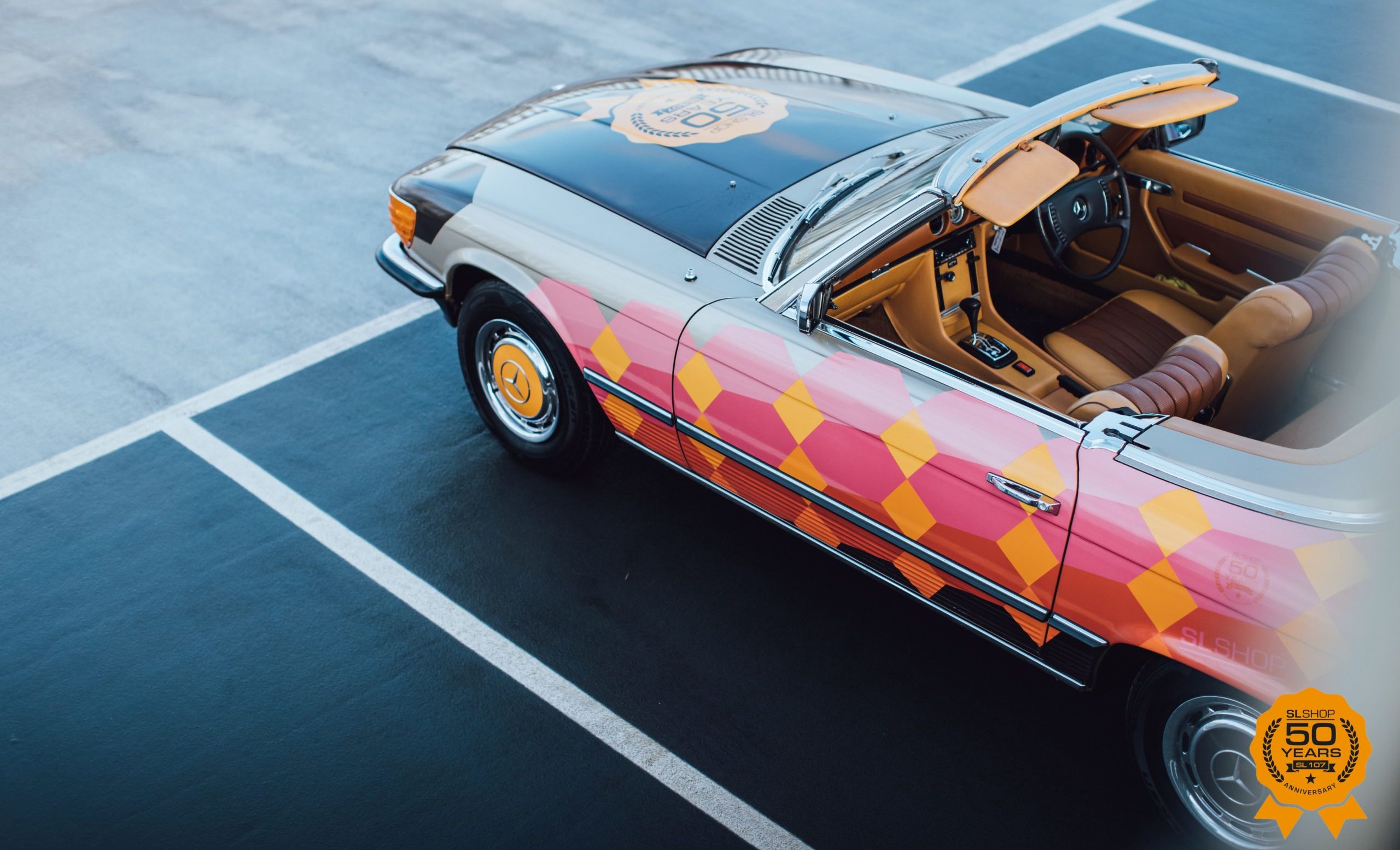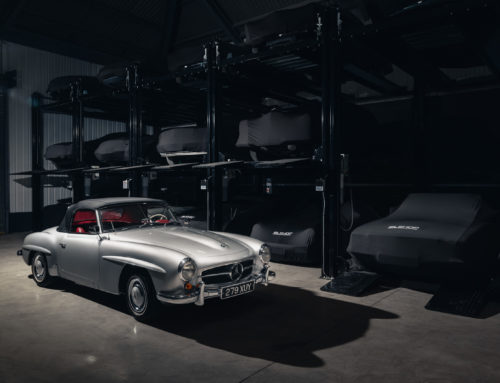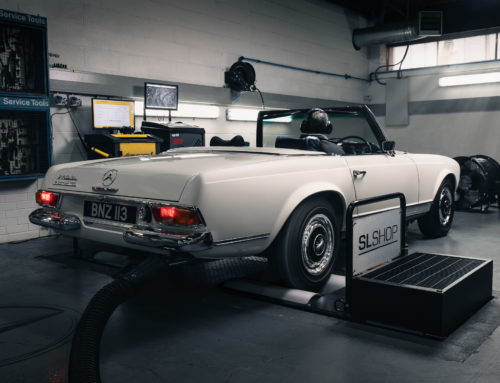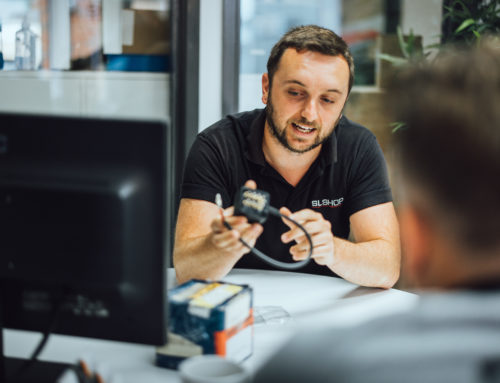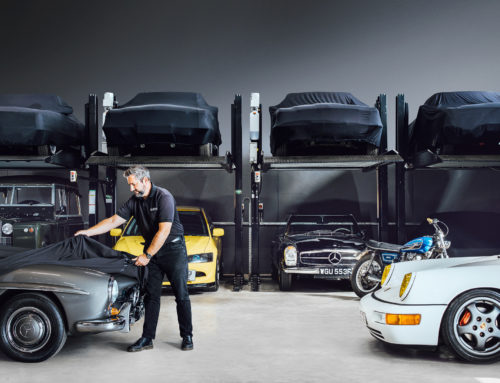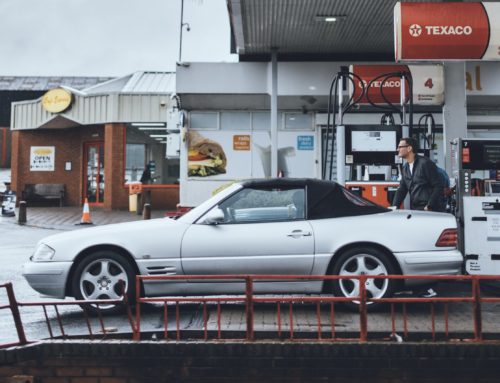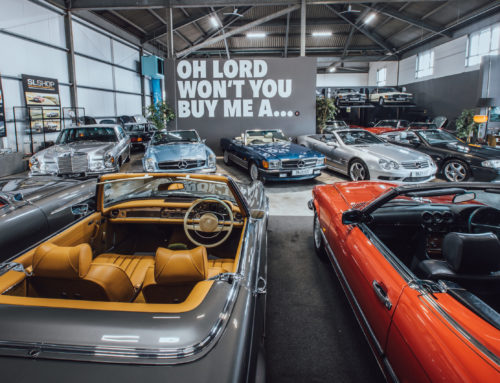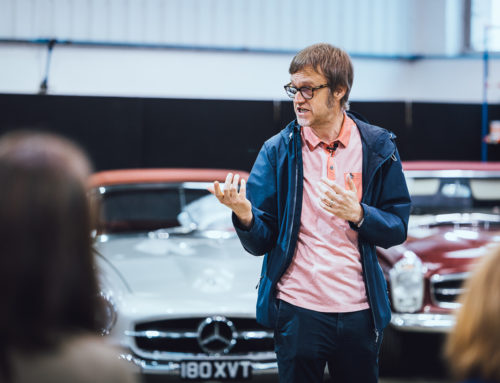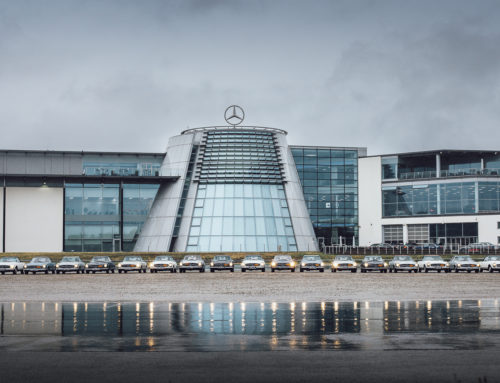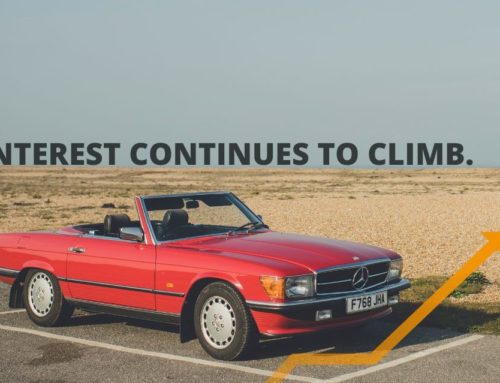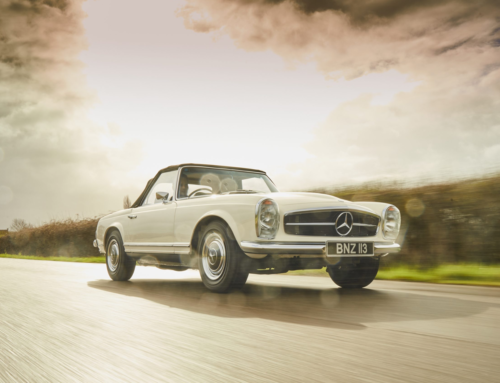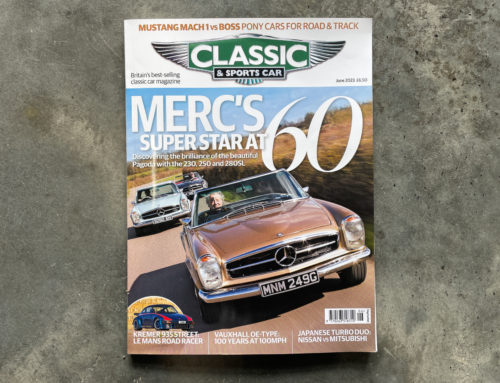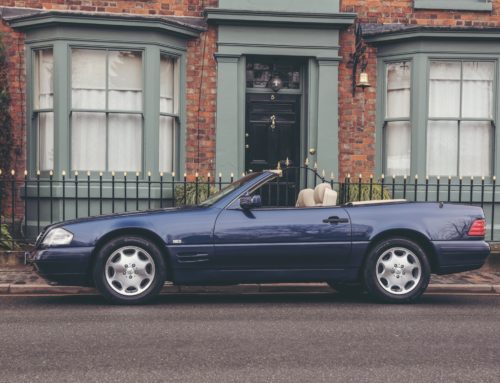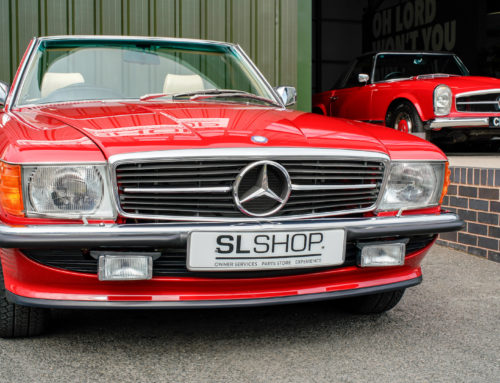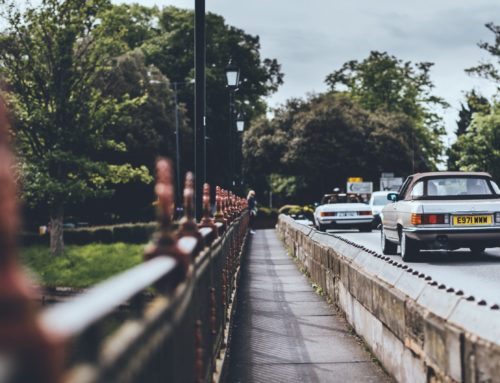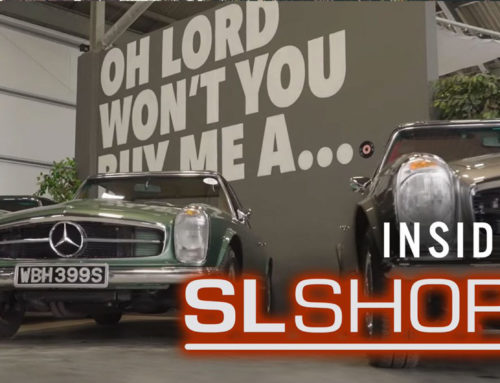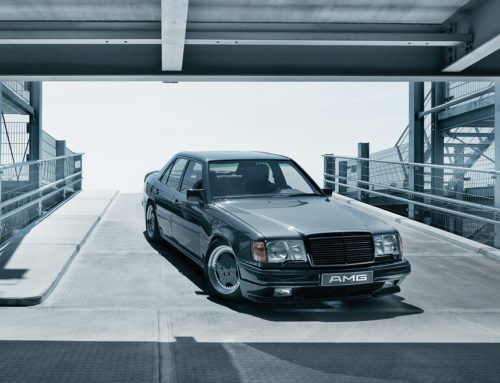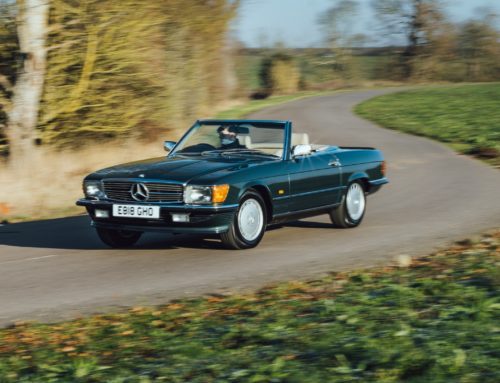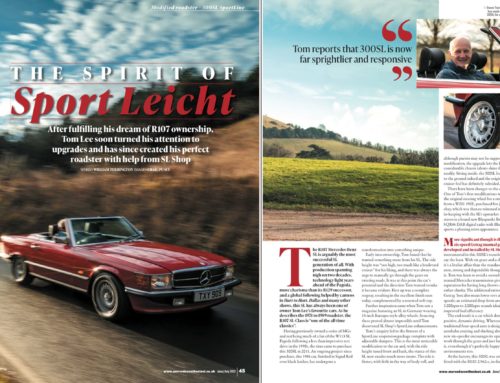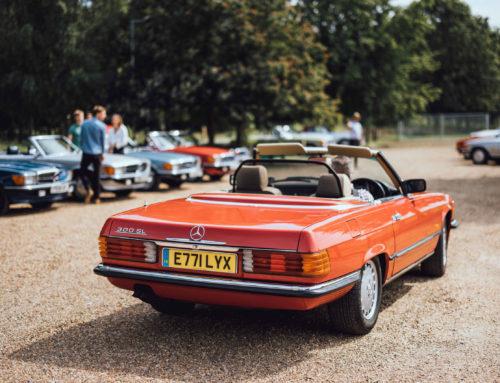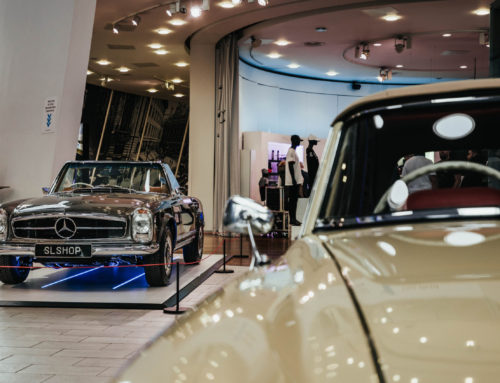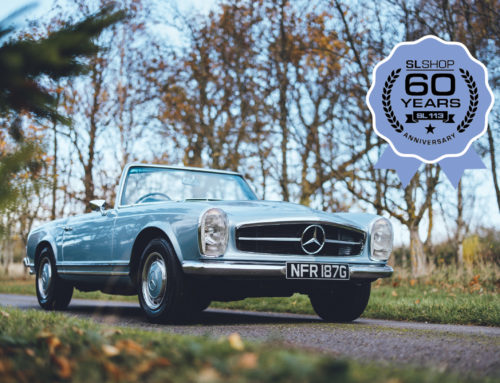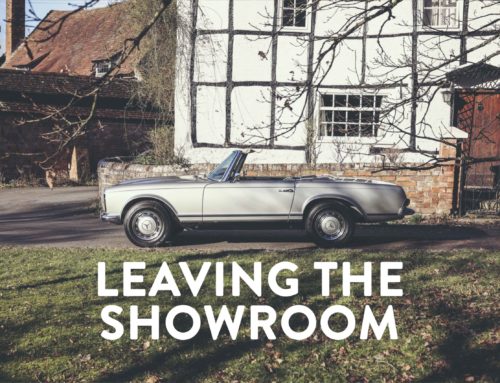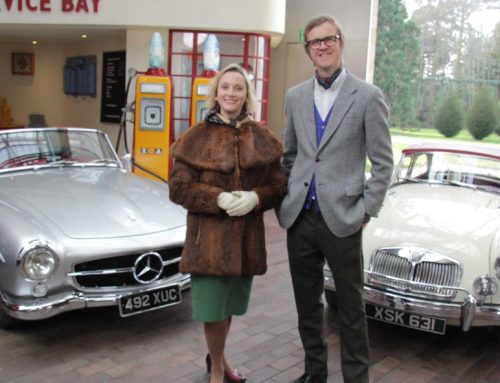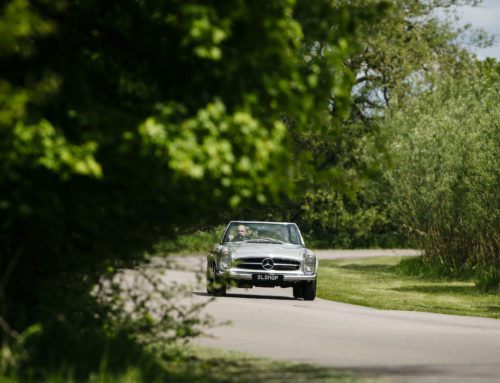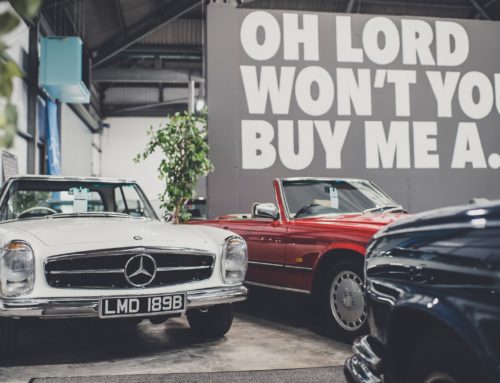The Mercedes R107 SL – Top 50 Facts
This year, the most popular Mercedes R107 of them all celebrates five-decades at the top of the sports-luxury pile. To commemorate this golden milestone, we explore 50 lesser-known details about this perennially popular and classy drop-top.
Due to the American car industry being held to account over the woefully unsafe Chevrolet Corvair, there was a general feeling that open-top cars were not right for the world. To counter this, the R107 was originally envisioned with a roll-over bar, much like the Triumph Stag. Thankfully, the braver elements in Stuttgart won the day and a fully open car was developed instead.
The R107 was the first SL to get an ‘R’ factory designation rather than a ‘W’ as with all the previous generations.
The doors of the R107 are fitted with special air ducts to direct air flow to keep the side windows and mirrors clear of muck.
In 1985 a catalytic converter was added to the SL, making this the first sports car from Mercedes-Benz to not only focus on increased safety and technology, but also reduced fuel emissions.
Although, in displacement terms, the 560SL represented the peak of the R107 range, due to that engine’s emissions control, the European 500SL was the top performer.
One film did more to cement the Mercedes R107 as an object of desire than all the official Mercedes-Benz marketing efforts combined. Paul Schrader’s 1980 Neo-Noir American Gigolo placed lead man Richard Gere in a 450SL. The film (which ironically saw Gere in the reverse role to Pretty Woman Julia Roberts’ street walker a decade later) portrayed an aspirational sex worker, collecting the finer things in life. His (or rather Schrader’s) choice of car would prove pivotal, contributing to the 450SL becoming a top seller in America.
The initial V8 engine used in the SL, the M116, wasn’t designed specifically for the open-top model. It had first been deployed to power the S-Class and rightly earned a bullet-proof reputation. Its design was over-square meaning it could rev without undue stress. The huge main and big-end bearings were more than up to the job, plus its crankshaft and connecting rods were made from forged steel. It would prove to be astonishingly reliable.
It’s common knowledge that those super-strong A pillars, were beefy enough to take the weight of the car in a roll. What’s less commonly known is that they were designed with computer assistance. They were also half again as strong as the ‘Pagoda’ SL’s.
It’s often thought that the decision to fit a V8 engine was purely taken to appeal to the American market. While it’s certainly true eight-cylinders sell better Stateside, there was more to it than that. The march of Mercedes-Benz safety innovation led to a new frontal impact crumple zone for the R107. If engineers had simply fitted an enlarged six-cylinder engine, its overall length would have compromised this pivotal safety measure.
As a product of the late 1960/early 1970s, many designs for the R107 incorporated the emerging ‘wedge’ styling. Though there is some very subtle evidence of this fashion trend present in the R107’s final design, it was the persistence of a more classical, conservative shape that kept this generation of SL looking fresh well into the 1980s.
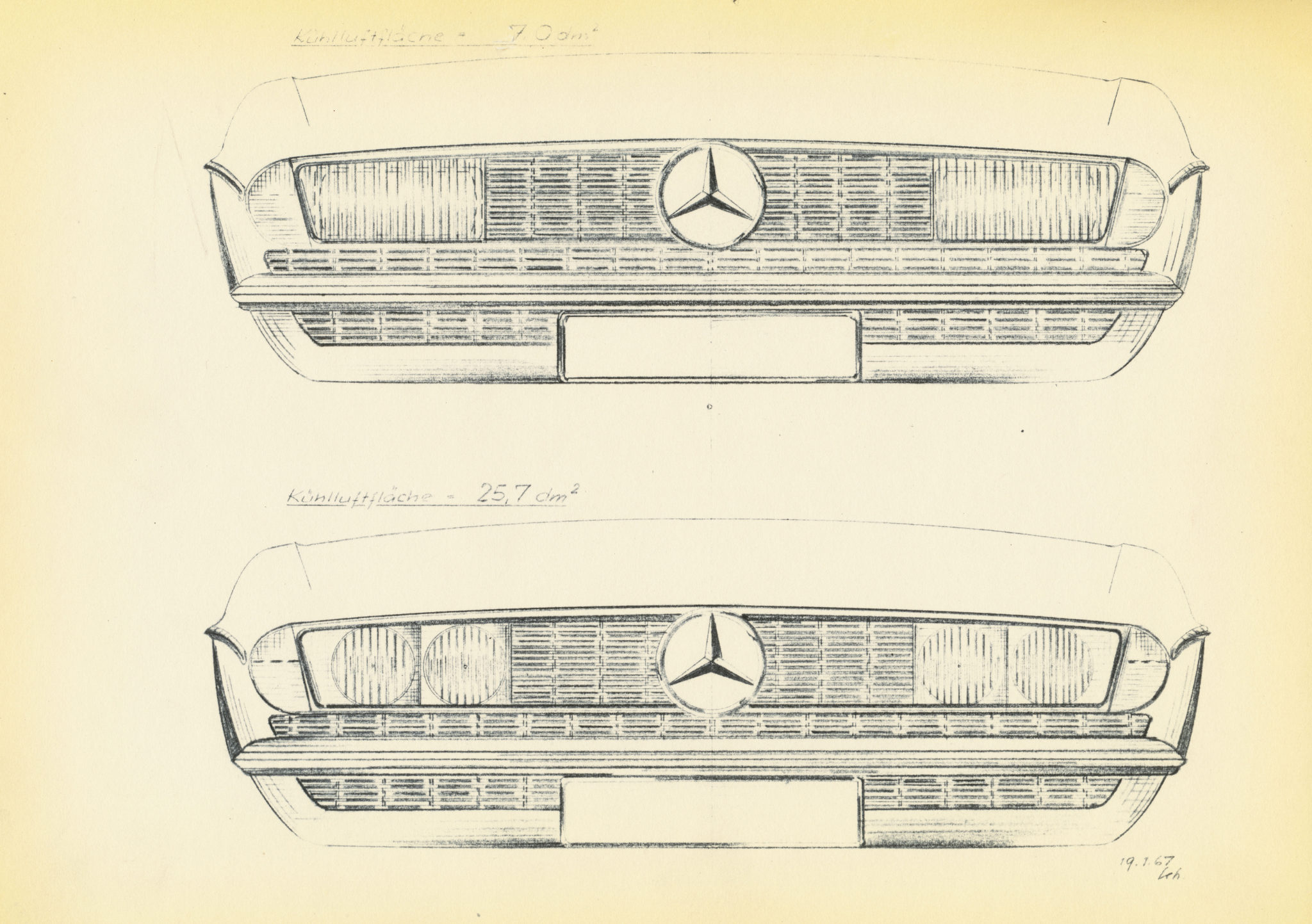
Mercedes-Benz SL (R 107, 1971 bis 1989). Dokument aus dem Design vom 19. Januar 1967 zur möglichen Kühlergrillgestaltung.
Mercedes-Benz SL (R 107, 1971 to 1989). Design department document dated 19 January 1967 for a possible radiator grille design.
The term ‘panzerwagen’ was actually coined by Mercedes-Benz staff during the production of the R107. It referred to the car’s greater use of steel, plus the strength of its construction. It wasn’t just rhetoric either, the US-spec R107 was nearly 350kg heavy than an equivalent early ‘Pagoda’ SL.
The inertia-reel belt was developed for the Mercedes R107. This new design automatically adjusted belt tension for different sized occupants and provided greater safety and comfort. It was so popular that it was quickly adopted by other manufacturers.
Initially introduced as a cost-effective yet still sporting solution to the worldwide fuel crisis, caused by the Yom Kipur war, the six-cylinder 280SL proved far more popular than initially imagined. Its smooth yet powerful 2.8-litre twin-cam engine was just 15bhp shy of the 350SL’s performance, plus you could get it with a manual gearbox – a first for the Mercedes R107. A six-cylinder model would remain right to the end of R107 production in 1989; long after fears of fuel supply had ceased.
Silver-and small-screen appearances throughout the Mercedes R107’s production only reinforced its deep cultural significance. Not least of these was the lead role in Dallas as the transport of choice for oil baron J.R. Ewing – a role that put this SL in front of tens of millions of viewers.
The new alloy M117 V8 was initially stress-tested in the low production run 450SLC 5.0 in case any problems were unearthed and costly recalls needed. Mercedes-Benz was cautious because its new engine was built using a technique known as chill-casting. The all-alloy block did away with conventional iron cylinder liners, in favour of a high-silicon-alloy material. This saved 40kg over iron, but was untested. It turned out that the engineers needn’t have worried, the engine proved just as strong and reliable as its forebear.
Famous early R107 owners in period included such diverse characters as Bruce Lee and Donna Summer. As the SL’s star was further ascending in the 1980s Madonna was seen driving one as was former US president Richard Nixon’s speech writer Ben Stein.
The 450SLC would be the most visible Mercedes-Benz modelin motorsport since the 1955 Le Mans tragedy. In just a few short seasons and with Mercedes-Benz providing its assistance to the UK importers running the team – rather than offering official factory support – the big SLC proved fiercely competitive in international rallying. Driven by rally greats Bjorn Waldegaard, Hannu Mikkola and Ingvar Carlsson these big coupes chalked up a series of wins and podiums on some of the toughest endurance rallies on earth. The swansong for the SLC was the 1980 Bandama Rally, in which Bjorn Waldegaard took the car’s final victory.
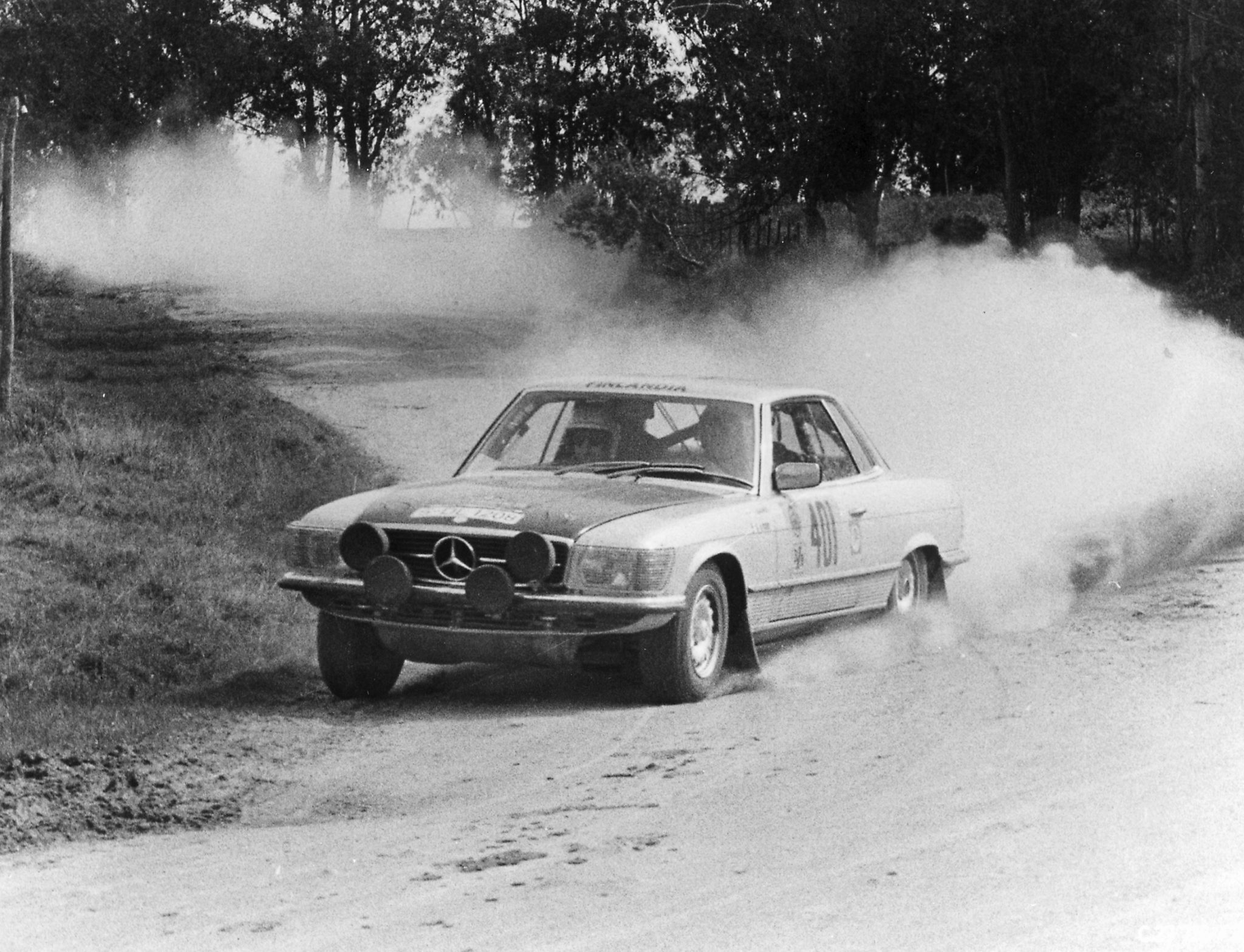
Mercedes-Benz 450 SLC 5.0 (Baureihe C 107, 1971 bis 1981) im Rallye-Einsatz, 1979.
Mercedes-Benz 450 SLC 5.0 (C 107 series, 1971 – 1981) during a rally, 1979.
By the early 1980s, the R107 had been on sale for over a decade and many pundits within the industry predicted that the announced 1982 upgrades would be the model’s last. Mercedes-Benz made no secret of the fact it was working on a replacement but, to the surprise of many, that new SL wouldn’t arrive until the end of the decade.
The front air dam, introduced in 1986 as part of a final facelift, wasn’t just a cosmetic update, it also reduced front-end lift by 30%.
The best-selling R107 of all was the longest running. A colossal 66,298 450SLswould account for more than a quarter of all the SLs sold.
Although it was wasn’t a scalpel-sharp sports car (or really ever trying to be), the R107 chassis was quite sophisticated. It incorporated anti-squat technology at the rear (on larger engine models) and the differential subframe acted as the pivot point for the semi-trailing arms. The front end featured anti-dive geometry and double wishbones; significantly more advanced than the swing-axle arrangement of its predecessor.
The deeply slatted rear and side-indicator lenses on the R107 were one of hundreds of very cleverly engineered components. Their grooved design ensured that air travelling through them sped up in the channels, keeping road debris to a minimum. The raised sections of the lights also trapped mud and snow thrown up by the car in motion, keeping the recessed sections clear and therefore 50% of the light was always visible.
Side flutes were employed on the bottom third of the R107’s body design to make it look lower and longer. This SL rode quite high above the ground, especially for a sports car, so this neat and effective visual trick helped fool the eye.
Because of the American hysteria surrounding safety in the late-1960s, most makers decided to forgo making full convertible sports cars altogether. That meant, for much of its production, the Mercedes R107 would go it alone. Its sole direct competitor only arriving in 1988, when Jaguar finally made a drop-top XJ-S (prior to this they only offered the Targa-topped XJ-SC).
More than 300k R107s were made, making it the most numerous SL of them all. Seriously impressive stuff, especially considering it was facing a ban when new and a fuel crisis shortly after.
Because the R107 received so many revisions and upgrades during its long production life, the model is generally split into two eras. Early cars built from 1971 to 1985 with less sporting suspension and styling, and the later cars built from 1986 to the end of production in 1989. The latter were given more up-to-date engines, taught chassis and cutting-edge safety and technology. As a result, they generally command a higher premium.
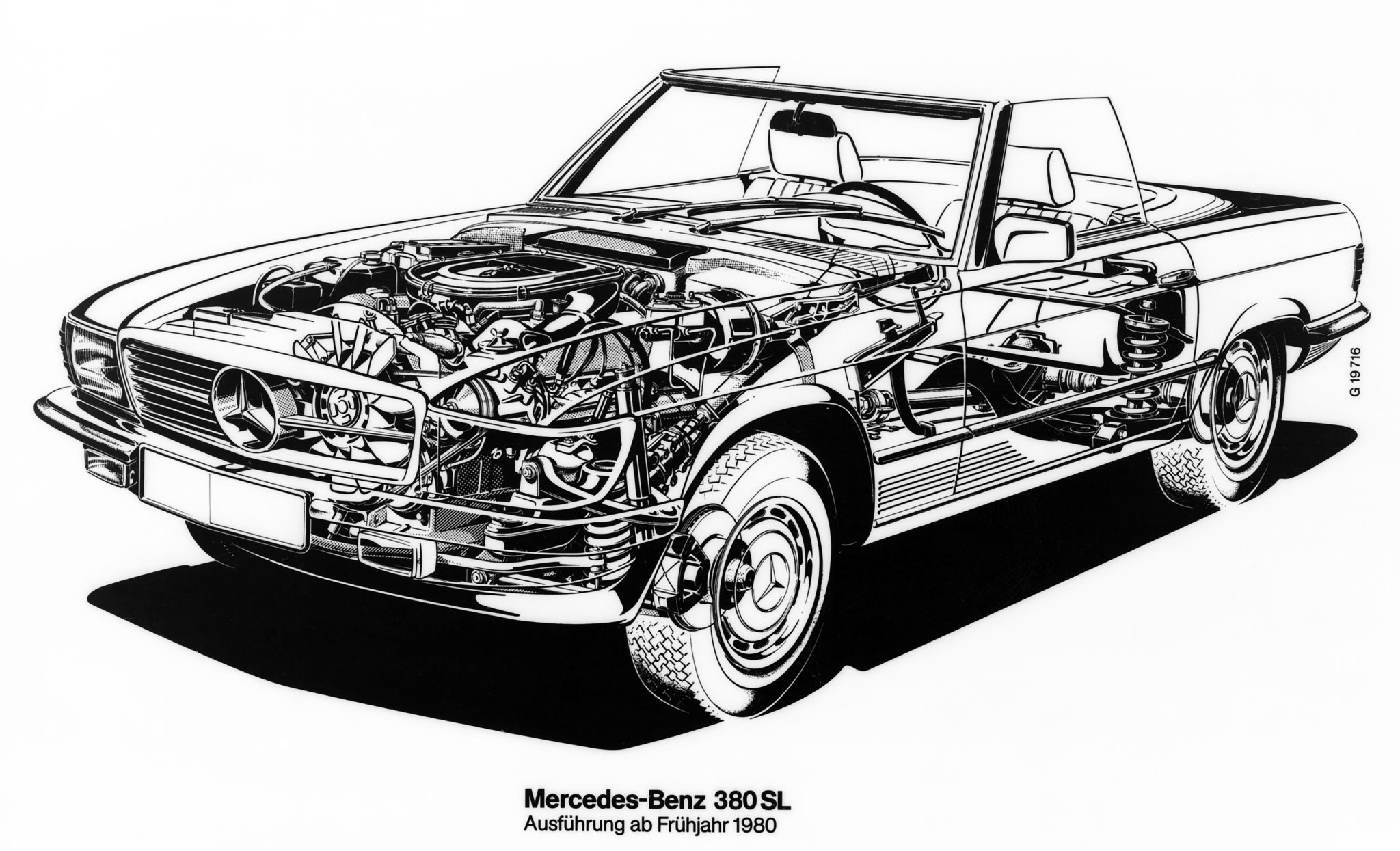
Durchsichtzeichnung, Mercedes-Benz Typ 380 SL (1980 bis 1985), Baureihe 107. Insgesamt wurde die Baureihe von 1971 bis 1989 gebaut.
X-ray rendering, Mercedes-Benz Type 380 SL (1980 – 1985) of the 107 series. Overall, the series was built from 1971 to 1989.
According to the members of the Benz world forum (benzworld.org) the R107 features in over 20 high-profile TV shows, air throughout the 1970s and 1980s. In this list are such classics as The A-Team, Miami Vice, Hart to Hart and Dynasty.
The 1984 poster for Beverley Hills Cop pictured Axel Fowley (Eddie Murphy) leaning on the bonnet of an R107. Later films in the franchise saw Fowley switch to driving Porsches, but in the artwork for the first film, it was this era of Mercedes-Benz that best represented Reagan’s affluent mid-1980s America.
According to a 1974 advertisement for the 450SL, ‘ladies will appreciate the entry and exit… Whether in evening dress or a brief skirt, ladies remain ladies.’ The Mercedes R017’s technology and safety might have been progressive, but sadly its advertising was very much a product of its time.
The Mercedes R107 has always been a costly machine. In its final year of production an entry-level 300SL would set you back £32,750 (approximately £87k today), with the range-topping 500SL advertised at £41,700 (nearly £110k today). Add in a few options and that price could quickly escalate still further. Air-conditioning cost £1943, metallic paint £583, an airbag £1227 and leather seats were £851.
In the early 1970s, world-famous formula one team owner Colin Chapman fell for the R107’s charms. In between race meetings he’d often use his 350SL to cross the continent. Its GT charms were said to have inspired Chapman to make more comfortable Lotus machines like the Eclat and the Esprit.
The same year the R107 was launched, 1971, was one of the bleakest in car production. That same year saw the American market ‘treated’ to the Ford Pinto, while us lucky Brits had to endure the arrival of the Morris Marina. Making the entry of the (admittedly far more expensive) SL even more welcome.
When launched in the US market, the 350SL cost nearly twice as much as a Jaguar E-Type. The old Jag had, of course, been on sale for a decade already, though these two would remain competing for sales until the E-type was replaced by the XJ-S in 1975.
Right-hand drive SLs benefit from the wipers parking on the passenger side, inadvertently maximising driver visibility.
Early R107s are a wonderful blend of the high-tech and the standards of the 1970s. For example, head rests, a hard-top roof and even an additional side mirror were all options. Though later, all would become standard equipment.
Though a costly option new, leather seats in the Mercedes R107 haven’t actually survived as well as the cost-option MB Tex material. This faux leather proprietary Mercedes-Benz covering first appeared in the late 1950s and remains in use today. It’s far more hardwearing than real leather and is such a convincing imitation of hide, that it’s often mistaken for it.
Two thirds of all R107s sold went to American customers. The original development of the model ensured it would appeal to transatlantic patrons and this early effort was rewarded.
Mercedes-Benz of the 1970s was head and shoulders above the mass majority of car makers. Its quality of engineering and safety innovation was second to none. For example, the R107 had a padded dash and steering wheel (with a collapsible column) not to mention ABS brakes under development (available as an option from 1980) with crumple zones front and rear. This SL was packed with features that wouldn’t become standard on other machines for decades.
Unlike all the other V8s, the American market 380SL engine was fitted with a single-row timing chain. The length of said chain meant it became prone to stretch, causing timing issues. It was recalled in period– most being replaced with the duplex-chain arrangement it always should have had – but inevitably, some will have escaped unmodified.
Allegedly, AMG made an SL for seven-time Formula One world champion Michael Schumacher. This uber SL was based on a 560SL, yet was powered by the 6.0-litre 380bhp V8 engine from the W124 ‘Hammer’. Its monstrous grunt was channelled through a limited-slip differential to enormously wide AMG split-rim alloy wheels. The car is reported to be one of only three ever made with the 6.0-litre engine and was last offered for sale in 2016 for 300k euros.
Though not officially folded into the Mercedes-Benz empire until 1999, the close ties between AMG and Stuttgart lead to the creation of plenty of appealing upgrades for the R107. The most popular customer requests were cosmetic; paint, body kits, alloys, and steering wheels, but there were also chassis and power upgrades too.
SLs have always attracted well-heeled and classy owners. Celebrities don’t always fall into the latter camp, but the ones who do aren’t just resigned to the history books. Current or very recent well-known R107 owners include; Jay Kay (twice owner at least), Jude Law, Lana Del Rey and BBC Radio One DJ Greg James.
In the late 1970s and early 1980s, buoyed by the success of the SLC in international rallying, AMG prepared a wide-arched 450SLC for Group 2 competition. The European Touring Car Championship (ETCC) was to be its stomping ground, though many were surprised at the form the long-anticipated three-pointed star’s return to the race circuit would take. Official factory support for circuit competition was withdrawn after the 1955 Le Mans disaster, so the SLC’s return was a big deal and Mercedes-Benz knew it. The cars were painted in silver (arrow) paint as were all of the support vehicles and the team overalls. The lead sponsor was drinks firm Mampe, who wanted to push its Lufthansa cocktail, why the car is sometimes called the ‘Lufthansa’ SLC.
The R107 is the latest classic machine to be given the popular American-invented resto-mod treatment. In addition to the SL Shop’s own ‘Sportline’ SL conversions, German firm Mechatronik has released some teaser shots and videos for its upcoming Project 107. This carbon fibre bodied 450SLC is pitched as a modern tribute to the old ‘Lufthansa’ AMG race car. It is powered by a modern AMG V8 drivetrain and will come in three versions from a relatively gentle ‘Touring’ entry to a frankly feral ‘Clubsport’. It’s expected to officially arrive on the market in summer 2021.
A production run of 18 years makes the R107 the second longest model line ever produced by Mercedes-Benz. Only the G-Wagon/G-Class can boast a longer production life (50 years).
An experimental 450SL was made by Mercedes-Benz in 1974 to test alternative fuels. Way ahead of the curve on caring about emissions meant that M-B was keen to explore ways in which it could continue to sell large-engine cars (especially in California). Using methanol instead of petrol meant the engine in this test mule had to have a higher-compression ratio (between 11:1 and 14:1) and suitably revised ignition. The car recorded a 20 percent increase in performance and vastly reduced harmful emissions, though the rating of the fuel meant it would need twice the amount of methanol to achieve the same range as petrol. That would have meant fitting a fuel tank that would not actually fit in the car!
All 300,174 R107s (coupes and convertibles), built in the model’s 18-year production, were built at the Sindelfingen plant just outside of Stuttgart.
Despite having 375bhp from its AMG-tickled V8, the ETCC 450SLC had to compete using a three-speed auto transmission. Homologation rules meant that if the road car only had an auto, then the race car had to use one too. As a result of this – plus facing stiff competition from BMW (635CSi) and Jaguar (JX-S V12)– it only recorded one win, the 1980 six-hours of Nürburgring. AMG’s attention soon turned to the new 190E 2.3-16 and the SLC was quietly forgotten.
At 1540kg the ‘Leicht’ part of the ‘Sportlich-Leicht’ (SL) moniker didn’t really apply to the R107.It was originally coined for the racing 300SL that weighed just 1293kg. As such a flagship brand for Mercedes-Benz, it’s kept the SL badge going ever since.
Join fifty R107 SL models for a day to remember as we drive in convoy from SLSHOP to Mercedes-Benz World – find out more details here.
Share With Your Fellow Petrolheads
The Mercedes R107 SL – Top 50 Facts
This year, the most popular Mercedes R107 of them all celebrates five-decades at the top of the sports-luxury pile. To commemorate this golden milestone, we explore 50 lesser-known details about this perennially popular and classy drop-top.
Due to the American car industry being held to account over the woefully unsafe Chevrolet Corvair, there was a general feeling that open-top cars were not right for the world. To counter this, the R107 was originally envisioned with a roll-over bar, much like the Triumph Stag. Thankfully, the braver elements in Stuttgart won the day and a fully open car was developed instead.
The R107 was the first SL to get an ‘R’ factory designation rather than a ‘W’ as with all the previous generations.
The doors of the R107 are fitted with special air ducts to direct air flow to keep the side windows and mirrors clear of muck.
In 1985 a catalytic converter was added to the SL, making this the first sports car from Mercedes-Benz to not only focus on increased safety and technology, but also reduced fuel emissions.
Although, in displacement terms, the 560SL represented the peak of the R107 range, due to that engine’s emissions control, the European 500SL was the top performer.
One film did more to cement the Mercedes R107 as an object of desire than all the official Mercedes-Benz marketing efforts combined. Paul Schrader’s 1980 Neo-Noir American Gigolo placed lead man Richard Gere in a 450SL. The film (which ironically saw Gere in the reverse role to Pretty Woman Julia Roberts’ street walker a decade later) portrayed an aspirational sex worker, collecting the finer things in life. His (or rather Schrader’s) choice of car would prove pivotal, contributing to the 450SL becoming a top seller in America.
The initial V8 engine used in the SL, the M116, wasn’t designed specifically for the open-top model. It had first been deployed to power the S-Class and rightly earned a bullet-proof reputation. Its design was over-square meaning it could rev without undue stress. The huge main and big-end bearings were more than up to the job, plus its crankshaft and connecting rods were made from forged steel. It would prove to be astonishingly reliable.
It’s common knowledge that those super-strong A pillars, were beefy enough to take the weight of the car in a roll. What’s less commonly known is that they were designed with computer assistance. They were also half again as strong as the ‘Pagoda’ SL’s.
It’s often thought that the decision to fit a V8 engine was purely taken to appeal to the American market. While it’s certainly true eight-cylinders sell better Stateside, there was more to it than that. The march of Mercedes-Benz safety innovation led to a new frontal impact crumple zone for the R107. If engineers had simply fitted an enlarged six-cylinder engine, its overall length would have compromised this pivotal safety measure.
As a product of the late 1960/early 1970s, many designs for the R107 incorporated the emerging ‘wedge’ styling. Though there is some very subtle evidence of this fashion trend present in the R107’s final design, it was the persistence of a more classical, conservative shape that kept this generation of SL looking fresh well into the 1980s.

Mercedes-Benz SL (R 107, 1971 bis 1989). Dokument aus dem Design vom 19. Januar 1967 zur möglichen Kühlergrillgestaltung.
Mercedes-Benz SL (R 107, 1971 to 1989). Design department document dated 19 January 1967 for a possible radiator grille design.
The term ‘panzerwagen’ was actually coined by Mercedes-Benz staff during the production of the R107. It referred to the car’s greater use of steel, plus the strength of its construction. It wasn’t just rhetoric either, the US-spec R107 was nearly 350kg heavy than an equivalent early ‘Pagoda’ SL.
The inertia-reel belt was developed for the Mercedes R107. This new design automatically adjusted belt tension for different sized occupants and provided greater safety and comfort. It was so popular that it was quickly adopted by other manufacturers.
Initially introduced as a cost-effective yet still sporting solution to the worldwide fuel crisis, caused by the Yom Kipur war, the six-cylinder 280SL proved far more popular than initially imagined. Its smooth yet powerful 2.8-litre twin-cam engine was just 15bhp shy of the 350SL’s performance, plus you could get it with a manual gearbox – a first for the Mercedes R107. A six-cylinder model would remain right to the end of R107 production in 1989; long after fears of fuel supply had ceased.
Silver-and small-screen appearances throughout the Mercedes R107’s production only reinforced its deep cultural significance. Not least of these was the lead role in Dallas as the transport of choice for oil baron J.R. Ewing – a role that put this SL in front of tens of millions of viewers.
The new alloy M117 V8 was initially stress-tested in the low production run 450SLC 5.0 in case any problems were unearthed and costly recalls needed. Mercedes-Benz was cautious because its new engine was built using a technique known as chill-casting. The all-alloy block did away with conventional iron cylinder liners, in favour of a high-silicon-alloy material. This saved 40kg over iron, but was untested. It turned out that the engineers needn’t have worried, the engine proved just as strong and reliable as its forebear.
Famous early R107 owners in period included such diverse characters as Bruce Lee and Donna Summer. As the SL’s star was further ascending in the 1980s Madonna was seen driving one as was former US president Richard Nixon’s speech writer Ben Stein.
The 450SLC would be the most visible Mercedes-Benz modelin motorsport since the 1955 Le Mans tragedy. In just a few short seasons and with Mercedes-Benz providing its assistance to the UK importers running the team – rather than offering official factory support – the big SLC proved fiercely competitive in international rallying. Driven by rally greats Bjorn Waldegaard, Hannu Mikkola and Ingvar Carlsson these big coupes chalked up a series of wins and podiums on some of the toughest endurance rallies on earth. The swansong for the SLC was the 1980 Bandama Rally, in which Bjorn Waldegaard took the car’s final victory.

Mercedes-Benz 450 SLC 5.0 (Baureihe C 107, 1971 bis 1981) im Rallye-Einsatz, 1979.
Mercedes-Benz 450 SLC 5.0 (C 107 series, 1971 – 1981) during a rally, 1979.
By the early 1980s, the R107 had been on sale for over a decade and many pundits within the industry predicted that the announced 1982 upgrades would be the model’s last. Mercedes-Benz made no secret of the fact it was working on a replacement but, to the surprise of many, that new SL wouldn’t arrive until the end of the decade.
The front air dam, introduced in 1986 as part of a final facelift, wasn’t just a cosmetic update, it also reduced front-end lift by 30%.
The best-selling R107 of all was the longest running. A colossal 66,298 450SLswould account for more than a quarter of all the SLs sold.
Although it was wasn’t a scalpel-sharp sports car (or really ever trying to be), the R107 chassis was quite sophisticated. It incorporated anti-squat technology at the rear (on larger engine models) and the differential subframe acted as the pivot point for the semi-trailing arms. The front end featured anti-dive geometry and double wishbones; significantly more advanced than the swing-axle arrangement of its predecessor.
The deeply slatted rear and side-indicator lenses on the R107 were one of hundreds of very cleverly engineered components. Their grooved design ensured that air travelling through them sped up in the channels, keeping road debris to a minimum. The raised sections of the lights also trapped mud and snow thrown up by the car in motion, keeping the recessed sections clear and therefore 50% of the light was always visible.
Side flutes were employed on the bottom third of the R107’s body design to make it look lower and longer. This SL rode quite high above the ground, especially for a sports car, so this neat and effective visual trick helped fool the eye.
Because of the American hysteria surrounding safety in the late-1960s, most makers decided to forgo making full convertible sports cars altogether. That meant, for much of its production, the Mercedes R107 would go it alone. Its sole direct competitor only arriving in 1988, when Jaguar finally made a drop-top XJ-S (prior to this they only offered the Targa-topped XJ-SC).
More than 300k R107s were made, making it the most numerous SL of them all. Seriously impressive stuff, especially considering it was facing a ban when new and a fuel crisis shortly after.
Because the R107 received so many revisions and upgrades during its long production life, the model is generally split into two eras. Early cars built from 1971 to 1985 with less sporting suspension and styling, and the later cars built from 1986 to the end of production in 1989. The latter were given more up-to-date engines, taught chassis and cutting-edge safety and technology. As a result, they generally command a higher premium.

Durchsichtzeichnung, Mercedes-Benz Typ 380 SL (1980 bis 1985), Baureihe 107. Insgesamt wurde die Baureihe von 1971 bis 1989 gebaut.
X-ray rendering, Mercedes-Benz Type 380 SL (1980 – 1985) of the 107 series. Overall, the series was built from 1971 to 1989.
According to the members of the Benz world forum (benzworld.org) the R107 features in over 20 high-profile TV shows, air throughout the 1970s and 1980s. In this list are such classics as The A-Team, Miami Vice, Hart to Hart and Dynasty.
The 1984 poster for Beverley Hills Cop pictured Axel Fowley (Eddie Murphy) leaning on the bonnet of an R107. Later films in the franchise saw Fowley switch to driving Porsches, but in the artwork for the first film, it was this era of Mercedes-Benz that best represented Reagan’s affluent mid-1980s America.
According to a 1974 advertisement for the 450SL, ‘ladies will appreciate the entry and exit… Whether in evening dress or a brief skirt, ladies remain ladies.’ The Mercedes R017’s technology and safety might have been progressive, but sadly its advertising was very much a product of its time.
The Mercedes R107 has always been a costly machine. In its final year of production an entry-level 300SL would set you back £32,750 (approximately £87k today), with the range-topping 500SL advertised at £41,700 (nearly £110k today). Add in a few options and that price could quickly escalate still further. Air-conditioning cost £1943, metallic paint £583, an airbag £1227 and leather seats were £851.
In the early 1970s, world-famous formula one team owner Colin Chapman fell for the R107’s charms. In between race meetings he’d often use his 350SL to cross the continent. Its GT charms were said to have inspired Chapman to make more comfortable Lotus machines like the Eclat and the Esprit.
The same year the R107 was launched, 1971, was one of the bleakest in car production. That same year saw the American market ‘treated’ to the Ford Pinto, while us lucky Brits had to endure the arrival of the Morris Marina. Making the entry of the (admittedly far more expensive) SL even more welcome.
When launched in the US market, the 350SL cost nearly twice as much as a Jaguar E-Type. The old Jag had, of course, been on sale for a decade already, though these two would remain competing for sales until the E-type was replaced by the XJ-S in 1975.
Right-hand drive SLs benefit from the wipers parking on the passenger side, inadvertently maximising driver visibility.
Early R107s are a wonderful blend of the high-tech and the standards of the 1970s. For example, head rests, a hard-top roof and even an additional side mirror were all options. Though later, all would become standard equipment.
Though a costly option new, leather seats in the Mercedes R107 haven’t actually survived as well as the cost-option MB Tex material. This faux leather proprietary Mercedes-Benz covering first appeared in the late 1950s and remains in use today. It’s far more hardwearing than real leather and is such a convincing imitation of hide, that it’s often mistaken for it.
Two thirds of all R107s sold went to American customers. The original development of the model ensured it would appeal to transatlantic patrons and this early effort was rewarded.
Mercedes-Benz of the 1970s was head and shoulders above the mass majority of car makers. Its quality of engineering and safety innovation was second to none. For example, the R107 had a padded dash and steering wheel (with a collapsible column) not to mention ABS brakes under development (available as an option from 1980) with crumple zones front and rear. This SL was packed with features that wouldn’t become standard on other machines for decades.
Unlike all the other V8s, the American market 380SL engine was fitted with a single-row timing chain. The length of said chain meant it became prone to stretch, causing timing issues. It was recalled in period– most being replaced with the duplex-chain arrangement it always should have had – but inevitably, some will have escaped unmodified.
Allegedly, AMG made an SL for seven-time Formula One world champion Michael Schumacher. This uber SL was based on a 560SL, yet was powered by the 6.0-litre 380bhp V8 engine from the W124 ‘Hammer’. Its monstrous grunt was channelled through a limited-slip differential to enormously wide AMG split-rim alloy wheels. The car is reported to be one of only three ever made with the 6.0-litre engine and was last offered for sale in 2016 for 300k euros.
Though not officially folded into the Mercedes-Benz empire until 1999, the close ties between AMG and Stuttgart lead to the creation of plenty of appealing upgrades for the R107. The most popular customer requests were cosmetic; paint, body kits, alloys, and steering wheels, but there were also chassis and power upgrades too.
SLs have always attracted well-heeled and classy owners. Celebrities don’t always fall into the latter camp, but the ones who do aren’t just resigned to the history books. Current or very recent well-known R107 owners include; Jay Kay (twice owner at least), Jude Law, Lana Del Rey and BBC Radio One DJ Greg James.
In the late 1970s and early 1980s, buoyed by the success of the SLC in international rallying, AMG prepared a wide-arched 450SLC for Group 2 competition. The European Touring Car Championship (ETCC) was to be its stomping ground, though many were surprised at the form the long-anticipated three-pointed star’s return to the race circuit would take. Official factory support for circuit competition was withdrawn after the 1955 Le Mans disaster, so the SLC’s return was a big deal and Mercedes-Benz knew it. The cars were painted in silver (arrow) paint as were all of the support vehicles and the team overalls. The lead sponsor was drinks firm Mampe, who wanted to push its Lufthansa cocktail, why the car is sometimes called the ‘Lufthansa’ SLC.
The R107 is the latest classic machine to be given the popular American-invented resto-mod treatment. In addition to the SL Shop’s own ‘Sportline’ SL conversions, German firm Mechatronik has released some teaser shots and videos for its upcoming Project 107. This carbon fibre bodied 450SLC is pitched as a modern tribute to the old ‘Lufthansa’ AMG race car. It is powered by a modern AMG V8 drivetrain and will come in three versions from a relatively gentle ‘Touring’ entry to a frankly feral ‘Clubsport’. It’s expected to officially arrive on the market in summer 2021.
A production run of 18 years makes the R107 the second longest model line ever produced by Mercedes-Benz. Only the G-Wagon/G-Class can boast a longer production life (50 years).
An experimental 450SL was made by Mercedes-Benz in 1974 to test alternative fuels. Way ahead of the curve on caring about emissions meant that M-B was keen to explore ways in which it could continue to sell large-engine cars (especially in California). Using methanol instead of petrol meant the engine in this test mule had to have a higher-compression ratio (between 11:1 and 14:1) and suitably revised ignition. The car recorded a 20 percent increase in performance and vastly reduced harmful emissions, though the rating of the fuel meant it would need twice the amount of methanol to achieve the same range as petrol. That would have meant fitting a fuel tank that would not actually fit in the car!
All 300,174 R107s (coupes and convertibles), built in the model’s 18-year production, were built at the Sindelfingen plant just outside of Stuttgart.
Despite having 375bhp from its AMG-tickled V8, the ETCC 450SLC had to compete using a three-speed auto transmission. Homologation rules meant that if the road car only had an auto, then the race car had to use one too. As a result of this – plus facing stiff competition from BMW (635CSi) and Jaguar (JX-S V12)– it only recorded one win, the 1980 six-hours of Nürburgring. AMG’s attention soon turned to the new 190E 2.3-16 and the SLC was quietly forgotten.
At 1540kg the ‘Leicht’ part of the ‘Sportlich-Leicht’ (SL) moniker didn’t really apply to the R107.It was originally coined for the racing 300SL that weighed just 1293kg. As such a flagship brand for Mercedes-Benz, it’s kept the SL badge going ever since.
Join fifty R107 SL models for a day to remember as we drive in convoy from SLSHOP to Mercedes-Benz World – find out more details here.
Share With Your Fellow Petrolheads
More from Journal
CARE
THE ULTIMATE CERTIFIED SERVICING INVESTMENT PLAN
Your ownership journey matters to us, which is why we have created a simple certified servicing investment plan, tailored to your individual needs and aspirations.
Start investing today and our dedicated CARE team will work with you to increase the value and enjoyment you receive from your vehicle.

STAY IN TUNE WITH SLSHOP MOMENTS
As part of SLSHOP’s community of enthusiasts, you’ll be the first to hear about events and tours, key product offers, exciting stories from owners around the world and of course… our latest additions to the showroom. So, be the first to know and you might just sneak a car on your driveway or take your car’s condition to new heights with our exclusive replacement parts.
Or, visit SLSHOP Journal
